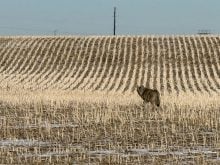Saskatchewan farm leader Ken McBride was calling for more government help even before he heard the latest news about provincial farm gross receipts declining during the first half of the year.
His demand was reinforced by the Aug. 24 report from Statistics Canada that farm receipts to the end of June had fallen almost six percent compared to last year because of a decline in government support.
McBride’s initial call was for the Saskatchewan government to put more money into farm support to respond to an Aug. 21 announcement that Alberta will spend $261 million this year to help farmers facing low prices and sharply rising costs.
Read Also

Agritechnica Day 3: Hybrid drive for a combine, data standards keep up to tech change and tractors of the year
Agritechnica 2025 Day 3: Hybrid drive for a combine, data standards keep up to tech change and tractors of the year.
“Alberta producers will receive a huge boost in funding that will leave Saskatchewan producers at a disadvantage to national and international competition,” McBride said.
The new Alberta support will pit farmers against other provincial treasuries, he said.
But McBride said the problem wasn’t really with Alberta’s decision to support its farmers. Instead, it was with Ottawa’s inability to support farmers nationally at a level that would allow them to compete with international subsidies.
“If the federal government had a commitment to strategic support for producers, provinces wouldn’t have to get into a competition for support,” he said in an Aug. 24 interview while harvesting on his farm.
“Because the issue is foreign subsidies, this is majorly a federal issue and responsibility.”
Statistics Canada figures for the first months of the year, show a decline in government support during the beginning of the Conservative government. This, despite payments from a $755 million grains and oilseeds program announced by the Liberals last year and delivered by the Conservatives this spring. The federal agency reported that farmer income from the market fell more than one percent despite higher canola receipts and cattle and calf sales and revenue.
Wheat and hog sales were worth less as prices fell.
More significantly, program payments of $2.6 billion during the first six months of the year were almost 22 percent below 2005 levels despite more than $580 million in special grains and oilseeds payments through the spring.
Almost $500 million of those payments, or 86 percent, went to producers in Saskatchewan, Alberta and Manitoba.
But payments from crop insurance and the Canadian Agricultural Income Stabilization program fell sharply, accounting for most of the dip in farm receipts.
The numbers do not reflect net income, which when published later this year will include the rise in energy costs, inputs and interest charges.
Statistics Canada said the $2.6 million in program payments was 17 percent higher than the previous five year average. Last year, program payments totalled just under $5 billion by Dec. 31.
During the last six months of the year, some farmers will benefit from several hundred million dollars in promised low-income farm payments.
As well, a retroactive reform of CAIS inventory values will pay out more than $900 million for the 2003-05 years, according to the government.
McBride said there are suspicions that those retroactive CAIS payments will mainly help cattle producers whose inventory values collapsed after BSE in 2003, rather than grains and oilseeds producers who are hardest hit by chronically low incomes.
According to Statistics Canada calculations, CAIS payments to the end of June totalled $836 million, down 24 percent from year-earlier levels.
Crop insurance payments were down 34 percent to $278 million.
There was some good market news. Canola revenues were up 35 percent to $1.1 billion and cattle receipts were higher, although plunging hog prices more than offset the cattle gains. Farm cash receipts, including program payments, declined in Ontario and the three prairie provinces.
While market receipts actually increased in Saskatchewan and Alberta, they were more than offset by lower program payments.
Meanwhile, revenues from market sales in Manitoba fell 13 percent during the six months and crop producers saw revenues from sales hit 12-year lows because of flood and excess rain damage in 2005.














